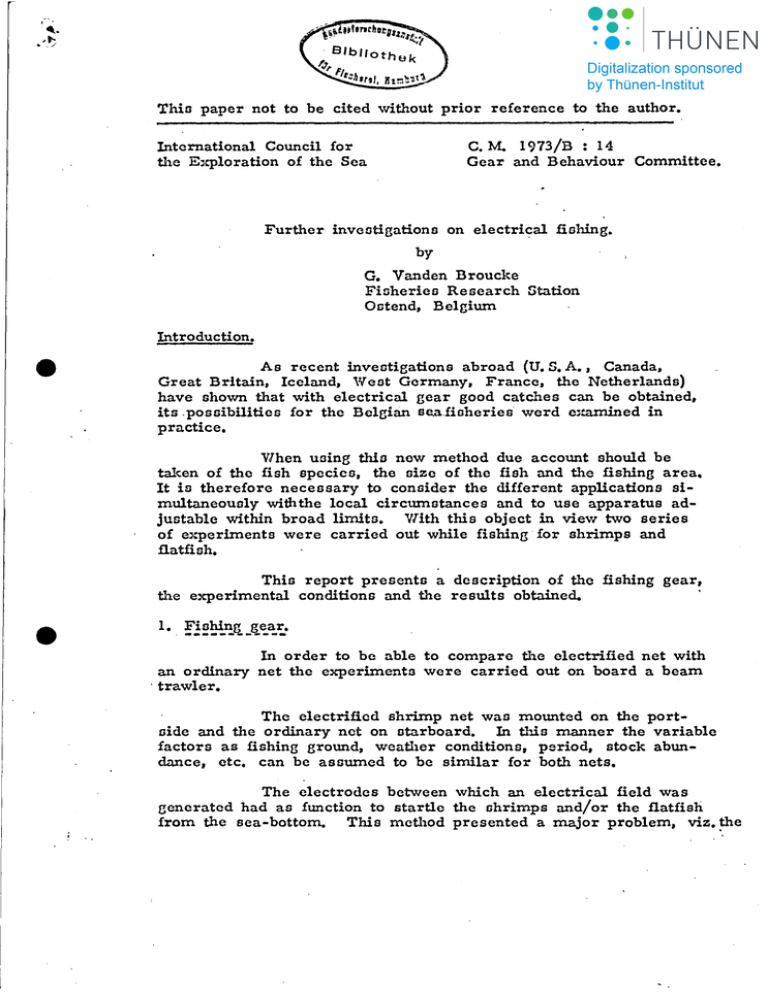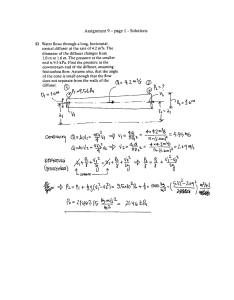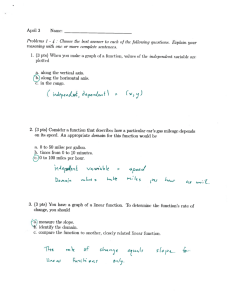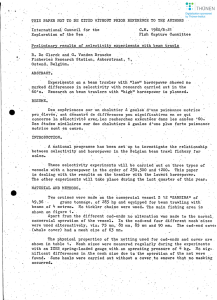Thia paper not to be cited without prior reference to... International Council for C. M. 1973/B : 14
advertisement

Thia paper not to be cited without prior reference to the author.
International Council for
the Exploration of the Sea
C. M. 1973/B : 14
Gear and Behaviour Committee.
Further inveotigationo on electrical fiahing.
by
G. Vanden Broucke
Fioheries Research Station
Ostend, Belgium
•
Introduction•
As recent inveotieations abroad (U. S. A. I Canada,
Great Britain, Ieeland, West Germany, France, the Netherlando)
have shown that with electrical gear good catches can be obtained,
its .posaibilities for the Belgian se.afisheries werd e:i:amined in
practice.
Vlhen uoing this now method due account should be
taken of the flsh spedes, the aize of the Hah and the fishing area.
It io therefore necessary to consider the different applications simultaneouoly withthe local circumstances and to use apparatus adjustablc within broad limits. VTith this object in view two series
of experiments were carried out while fishing for shrimps and
flatfish.
This report presents adescription of thc fishing gear,
the experimental conditions and thc results obtained.
•
In order to be able to compare the electrified net with
an ordinary net the experimenta were carried out on board a beam
. trawler.
The electrified shrimp net was mounted on the portaide and the ordinary net on starboard. In this manner the variable
factors as fiahing eround, weather conditions, period, stock abundance, etc. can be assumod to be similar for both nots.
The clectrodes between which an electrical Held was
generated had as function to starUe the shrimps and/or the flatfish
from the sea-bottom. This method presented a major problem, vize ~e
2.
protection of thc elcctrodeo against damage.
Moreover the clec~ri­
cal field should not cause any frightening effect in front of the not.
This last point is very important with rega:-d to the catchability.
Thc first problem, the damagc to the electrodcs, was
partially eliminated by mounting the clcctrodcs in t..'le direction of
towing (figure 1).
On thc one hand this rcsulted in thc clectrode3
following up quitc well thc roußlmcss of thc bot-::om. and good contact
thus existed between bottom and c1cctrodeo (lnd on the other hand
the chance of damagc to the eloctrodcG ·Nr..U ncgligible.
•
Thc frightcnine t::f.fcct in the front part of the net
opening may be caused by the clectroces 0:" thc clectrical field
being placed too near.
To cnsure that the clcctrical field was
effcctivc under thc upper part of the net, the electrodeo were
isolatcd till thcy touched tho bottom anti were fixed to the beam
by cables.
Two cables from the impulo generator to the net
guaranteed the power supply.
Thcce cables wcre shot and hauled
together with thc fishing gear.
The feeding of thc impuls generator on board of vessel
WaS obtained by a motor-altcrnator unit of 2. 5 1<VA with an alternating tension of 220 Volt.
Figure 2 gives a block diagram of the instrumentation
used.
•
The first serics of experiments wao carried out on
board a beam-trawler of 29.30 gross tonnage and equipped with
a motor of 200 HP•
The fishing groundo were located off the Belgian coast
between Zeebruges and Knocke.
The experiments took place durinß
the month of September 1972 undcr varying ·.vcather conditions.
The sccond series of experiments took place on board
a otern bcam trawler of 29.9 gross tonnage and cquippcd with a
motor of 150 HP.
Thc fishing ground wa,l also located off thc Belgian
coast, but this time opposite thc fishing harboul' cf Ostend.
The
period was the beginning of June 1973 and the weather conditions
were rather bad.
3.
3. Results andconc1ucions.
The objectives of the research were to some extent
different for flatfish and for shrimps. As reGards flatfish a
selectivc fishcry and a simplifieation of the fishing Bear (the substitution of hcavy tielders by lieht eleetrodeo) '\vcrc aimed at.
With respcct to thc shrimp fishcry it VlaS endeavoured
to develop a switch-over from tho traditional night-timc fishery
to a day-time fishery.
Simultaneously, an attempt was made to
increase the selectivity.
a. Results.
•
Two main points were examined, vize thc catehes and
the sclectivity.
As regards the first series of o,::pcriments the contents
o{ the cod-end of both neto were compared for 1 ü hauls in a total
of 20.· Ten experimental hauls had to be discarded for teehnieal
or fortuitous reaGons (not damage, _ etc.).
Thc eatehes consistcd mainly of shrimps and soles
so that no eomparison for other flatfish was possible.
The eontents of the eod-end of the ordinary net was taken us referenec
and the cateh obtained by the not with eleetrodcs was expressed in
pcreontageo of the eateh obtained by the ordinary nct.
Thc results were rather favourable
•
- for shrimps : 1'1-1 % E. N. (total eateh 65 kg)
- for eommercial soles : 350 % E. N. {total eatch
45 specimens}
- for inunature soles
76 % E. N. (total catch
76 specimens)
The seleetivity of thc net with elcctrodcs gave no
diotinct results for shrimps.
For soles a ccrtain degree of solcetivity was aseertained
especially far the immature solos.
The input peak tension was 100 volt and the frequeney
2 Hertz.
Thio adjustment was kept indentieal durine 10 hauls in
order to obtain a signifieant eomparison.
4.
From the aecond aeries of experiraents twelve valuable
hauls werc obtained. In these experiments anothel' distance between the electrodes and another frequency (10 Hertz) was introduced.
The input peak voltage was 100 Volt.
The results were also favourablc :
- for shrimps : 143 % E. N. (total catch 43 kg)
- for soles : 300· % E. N.. (total catch 39 spccimims)
b. Concluoions.
•
The main conclusion of these experiments' is that the
electro-fishing presents good perspectives as regarda
- the catchability for shrimps and aoles
- the selcctivity for soles.
Research raust be continued alone thc same lincs but
varying the adjustment of the impuls generator (frequency, peak
tension), the distances betwecn the e1ectrodes and thc environmenta1
conditions.
Finally, the investigations should lead to the development of a compact inotrument which may be fb:cd on thc beam or
on the headline of thc nets ; thc cable connection bctween vesselfishing gcar would then bccome unnecessary•
•
-I_otor_f-
I
Alternator
I
<
input 220V_AC
Pulse _counter
Pulse _generator
-
Oscilloscope
.
-. -to the ne t
..-s
output
Figure 1_ Block diagram
el ctrodes
Figure 2 _ Beamnet with electrodes




